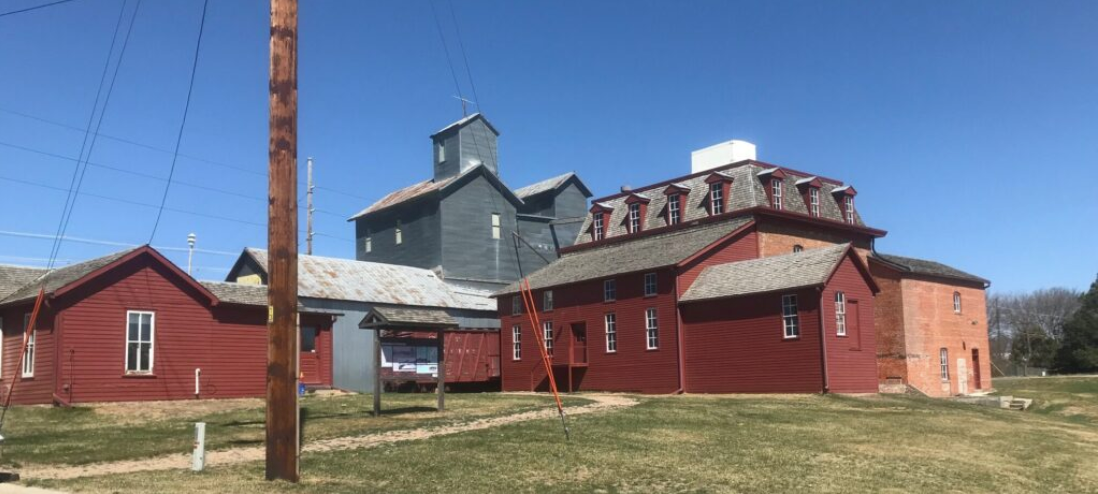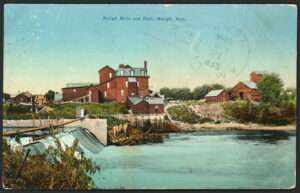
By PAUL HAMMEL
Nebraska Examiner
Step inside the Neligh Mill, and step back to the late 1800s.
That’s when flows from the Elkhorn River turned a huge waterwheel, which in turn churned gears and millstones inside the impressive brick mill. There, grains grown on nearby farms were ground into wheat, rye and buckwheat flour.
Built by town founder
One was even called “Gold Medal Flour” until the giant Minneapolis miller, General Mills, purchased away the sole rights to the name.

The Neligh Mill was built in 1873 by the founder of the northeast Nebraska town, Thomas Neligh, with elevators to store wheat and corn added later.
Even today the community fetes the landmark enterprise by calling its annual 4th of July festival “Old Mill Days.”
So when the state historical society, the owner of the Neligh Mill, considered tearing down elevator and warehouse additions to the landmark mill, local residents took notice.
Plan to preserve one elevator
The result, after a public meeting in Neligh and a meeting there of the History Nebraska Board?
Portions of the aging structure, a corn elevator and warehouse which have leaks in their roof and a resident population of bats, are slated for demolition.
But the vote by the History Nebraska Board also calls for investigating preservation of a wheat elevator that was added onto the mill in 1886.
To be clear, preservation of the original mill, described as the last, fully intact 19th-century flour mill in the state, was never in doubt. But now, the state is looking at saving one of the later additions, a wheat elevator.
A compromise
It’s being described as a pretty decent compromise for the structure, which is on the National Register of Historic Places.
“I like the idea,” said Roxanne McNally, a member of the Antelope County Historical Society. “It’s keeping part of it that’s historically significant.”
Harv Ofe, the longtime site supervisor of the mill, said opinions were split when a public meeting was held in Neligh over the future of the structure, which is a state historical site.
A roof linking the wheat elevator with a corn elevator had begun leaking again, and History Nebraska was looking at $172,000 to fix the leak and reroof the three structures.
Town meeting
At the meeting, attended by about 25 local supporters of the Neligh Mill, there was talk of tearing down both the wheat and corn elevators — tin-side structures where those crops were stored before being ground up — and the warehouse.
But when the History Nebraska Board met earlier this month in Neligh, a compromise of sorts was struck to explore saving the wheat elevator, the older of the two elevators and the one historically linked to the grinding of flour.
Ofe called it “the best option.”
“Elevators of this nature are disappearing from the landscape,” he said. “That would more or less satisfy both sides of this debate.”
A top flour producer
The inside of the Neligh Mill looks just as it did in 1969, when the mill — then grinding livestock feed — shut down, Ofe said.
The last flour was produced at the mill in 1959, he said, but the steel rollers, which replaced the stone grinders in 1886, are still intact. A millstone remains on display.
At one time, the Neligh Mill was among the top 10 producing mills in the state, Ofe said. Its dozen employees worked around the clock, in two shifts.
When the mill was operating, the sounds of flour production echoed throughout the town, which hugs the Elkhorn River, about 35 miles west of Norfolk.
Everyone ‘loves the mill’
“Everyone out here loves the mill,” said Neligh attorney Jim McNally. “It’s a great attraction.”
Ofe said the future of the mill, which attracts about 3,400 visitors a year, looks bright, given the plan approved by the History Nebraska Board. The Cowboy Trail, a hike-bike trail, runs alongside the mill, and Neligh will celebrate the 150th anniversary of its founding next year.
Jill Dolberg, the deputy state historic preservation officer for History Nebraska, said no one likes to tear down even parts of a historic structure. But she said the state agency has been wrestling with the future of the mill complex for several years.
There was consideration of using the elevators as a visitors center, Dolberg said, but there wasn’t much room for that on the ground floors. Tour and school groups haven’t been allowed in the elevators because of the bats and because the stairs that reach the upper stores of the elevator are too steep for the public.
Four options were presented at the public meeting in Neligh in March, ranging from doing nothing to tearing down both elevator additions and the warehouse. None was a “perfect solution,” Dolberg said.
Structural engineer
The compromise reached by the History Nebraska Board in April, she said, will honor the original mill, which recently had its brick tuck-pointed and some cedar siding replaced. And by removing the 1899 corn elevator and warehouse, Dolberg said, it will open up the view of the brick mill structure.
She said her task now is to consult with a structural engineer to see what it will take to save the wheat elevator. Dolberg will report back to the History Board in July.
“What is important for me now is to explore all of the options and find the best solution,” she said last week.




